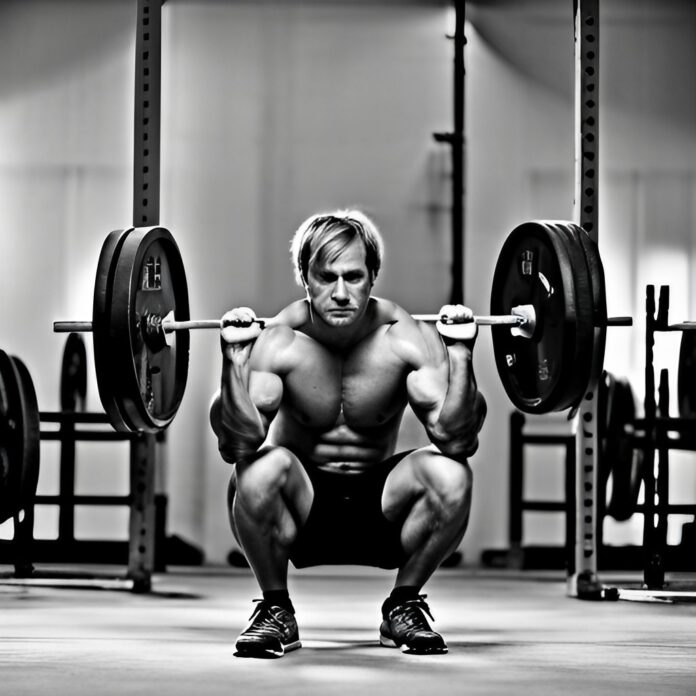Leg day is to the fitness enthusiast what hump day is to the workweek—an inevitable challenge that demands grit, determination, and endurance. At the heart of this workout day often lies a fundamental question for those looking to sculpt their lower body to perfection: do lunges or squats reign supreme? It’s a hotly contested debate that has divided gym-goers and fitness professionals for years.
In this comprehensive breakdown, we’ll strip away the mystery surrounding these two powerhouse exercises and uncover which one deserves a spot at the forefront of your leg-blasting regimen.
Squats
Squats are often hailed as the quintessential lower-body exercise, a title they’ve earned due to their unparalleled ability to target multiple muscle groups in a single, fluid motion. When performed correctly, squats engage the quadriceps, hamstrings, gluteal muscles, and even the core, providing a comprehensive workout that strengthens and tones.
The beauty of squats lies in their versatility. They can be executed with or without weights, making them accessible to fitness enthusiasts at all levels. For beginners, bodyweight squats help in mastering form and building foundational strength. On the other hand, adding weights, whether it be a barbell, dumbbells, or kettlebells, can significantly up the ante, challenging even the most seasoned athletes.
Another advantage of squats is their real-world applicability. The motion of squatting is a fundamental human movement that translates into improved functional strength, aiding in daily activities and enhancing overall quality of life. Furthermore, consistent squatting can lead to improvements in balance, posture, and mobility.
However, the effectiveness of squats is highly dependent on maintaining proper form. Key components include keeping the feet shoulder-width apart, driving through the heels, keeping the back straight, and ensuring the knees do not extend past the toes. This ensures the safety of the joints and maximizes the engagement of target muscle groups.

In sum, squats are an indispensable part of a well-rounded fitness regimen, celebrated for their ability to sculpt and strengthen the lower body, improve functional capabilities, and deliver results that extend far beyond the gym.
Muscles Worked by Squats
Squats are rightfully acclaimed for their efficiency in targeting multiple muscle groups simultaneously, contributing to their status as a staple in leg day workouts. The primary muscle groups engaged during a squat include:
- Quadriceps: The front thigh muscles are crucially worked as you extend your knee and rise from the squatting position.
- Hamstrings: Located on the back of your thighs, the hamstrings play a supportive role, especially as you lower into the squat.
- Gluteus Maximus, Medius, and Minimus: These posterior muscles are intensively activated as you drive upwards from the bottom of the squat, providing power and stability.
- Adductors: The inner thigh muscles are engaged to stabilize your legs during the squat motion.
- Core Muscles: Squats are not just about the legs; your abdominal and lower back muscles are engaged to maintain balance and posture throughout the exercise.
- Calves: Though not the primary focus, the calf muscles receive a workout as they assist in the stabilization of your legs.
This comprehensive muscle engagement is what makes squats such an effective exercise for building strength, enhancing mobility, and boosting overall fitness. Proper form and technique are paramount to activating these muscle groups effectively and preventing injury.
The Anatomy of Lunges and Squats
Before we can declare a winner, it’s crucial to understand the fundamental mechanics of both movements. Squats, often considered the king of lower-body exercises, target the quadriceps, hamstrings, and glutes through a vertical motion. The traditional back squat involves significant trunk and core stability, improving overall strength and balance.
Lunges, the more dynamic cousin of squats, replicate a horizontal split stance from a neutral position. This exercise demands unilateral strength, enhancing balance, and core engagement. Lunges are exceptional for isolation and stabilization, as they recruit one leg at a time, preventing muscle imbalances that can arise from bilateral movements.
For those interested in broadening their workout regimen to include expert advice on daily exercises beyond lunges and squats, a comprehensive guide can be found on famed trainer Harley Pasternak’s recommended daily workouts. This resource offers a deeper insight into achieving a balanced fitness routine that caters to all aspects of physical health. Discover more at Harley Pasternak’s Daily Workout.
Which Move Packs a Greater Punch?
Squats: The Foundation of Strength
Squats’ claim to fame is their sheer versatility. They can be performed using different variations, such as the front squat, goblet squat, or sumo squat, each tweaking the emphasis on your leg muscles slightly. For many, squats are the go-to exercise due to the weight they can shift and their ability to engage the largest muscle groups in one simple movement.
Lunges: Unilateral Power Play
While lunges may not have the same reputation as squats, they should not be underestimated. The lunge’s unilateral nature is precisely why it’s so effective; it exposes and corrects muscle imbalances, and has a profound impact on the development of gluteus medius, the often-neglected muscle responsible for lateral stabilization.
The Call to Action for Leg Day
In the pursuit of the perfect physique, it’s not about choosing one exercise over the other, but understanding how these exercises complement each other. For a well-rounded leg day, it’s recommended to start with the compound movement of squats to leverage maximum weight and muscle activation. Follow up with lunges to zone in on specific muscle groups and incorporate balance and stability into your routine.
Expert Insights and Testimonials
To settle the score once and for all, we turned to fitness professionals who have first-hand experience on the matter.
Testimonial 1
“My clients love the challenge that lunges bring to their leg day routine. Not only do they feel the burn, but by integrating walking lunges, we can work on form and core stability,” says Personal Trainer Nicole.
Testimonial 2
“Nothing beats a heavy back squat for building total leg strength, but don’t sleep on lunges for their injury prevention and unilateral muscle balance benefits,” advises CrossFit Coach and Athlete David.
A Focus on Form and Technique
Regardless of which exercise you favor, proper form and technique are non-negotiable when it comes to reaping the benefits and minimizing the risk of injury. Rounded backs, caving knees, and heels lifting off the ground are just a few of the common mistakes that can occur during lunges and squats.
When performing a squat, focus on maintaining a neutral spine, keeping your feet shoulder-width apart and your knees tracking over your toes. For lunges, step forward and lower your body until your front thigh is parallel to the ground, ensuring your back knee hovers a few inches above or lightly touches the ground.
Introducing Variations for Challenge and Progress
To keep things interesting and continuously challenge your lower body, consider adding variations to both lunges and squats. For squats, try pause squats or jumping squats for a change in tempo and increased explosive power. For lunges, lateral lunges, reverse lunges, and even jumping lunges can take your workout to the next level.
The Role of Equipment in Leg Day
Barbells, dumbbells, kettlebells, resistance bands—even your body weight can all be used effectively in both lunges and squats. Each piece of equipment provides a slightly different challenge, allowing for modifications in weight and range of motion. It’s important to choose the equipment that aligns with your fitness level and specific goals.
Achieving Balance in Your Leg Day Routine
A balanced leg day routine integrates not only lunges and squats but also other accessory exercises. These may include deadlifts, leg press, calf raises, and hamstring curls. Incorporating a variety of movements ensures that every aspect of your lower body is appropriately worked, leading to comprehensive development and reducing the chance of stagnation.
Tracking Progress and Setting Personal Goals
Whether you’re tracking your one-rep max for squats, the number of bodyweight lunges you can do in a minute, or the level of soreness you feel the day after, setting personal goals is key to staying motivated and pushing your limits. Don’t compare your progress to others—instead, focus on the milestones you’re hitting and the strength you’re building within yourself.
For those looking to deepen their understanding of squat and lunge techniques, enhance their workout routines, or simply find more expert advice, there are several invaluable resources online. Here are a few recommended links to check out:
- Starting Strength – A comprehensive guide by Mark Repetto on strength training, focusing on the mechanics and benefits of squats.
- Bodybuilding.com – This vast exercise database includes detailed instructions and videos on how to perform lunges and squats correctly.
These platforms offer a wealth of information for both beginners and seasoned athletes looking to perfect their technique or spice up their leg day routines.
Final Thoughts on the Squat vs. Lunge Debate
When it comes to lunges or squats, there’s no one-size-fits-all answer. Both exercises have their unique benefits, and the debate isn’t about choosing a side but understanding how they can work in harmony to achieve a well-rounded leg day. Incorporate both into your routine, focus on form, challenge yourself with variations, and most importantly, keep moving forward with your fitness goals. Remember, the best exercise for you is the one that you enjoy and can perform safely and effectively. Whether you’re team #LungeLife or team #SquatSquad, the important thing is that you’re getting out there and putting in the work.


